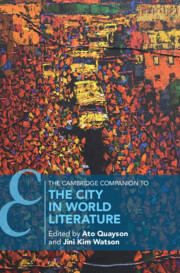Book contents
- The Cambridge Companion to the City in World Literature
- The Cambridge Companion to the City in World Literature
- Copyright page
- Contents
- Contributors
- Chronology of Political, Literary, and Cultural Events
- Chapter 1 Introduction
- Part I Critical Approaches
- Part II Spotlight Literary Cities
- Chapter 5 The Neighborhood and the Sweatshop
- Chapter 6 “The Whole World in Little”
- Chapter 7 Unworlding Paris
- Chapter 8 Sketching the City with Words
- Chapter 9 Romance and Liminal Space in the Twentieth-Century Cairo Novel
- Chapter 10 Bombay/Mumbai and its Multilingual Literary Pathways to the World
- Chapter 11 At Home in the World
- Chapter 12 Imagining the Migrant in Twenty-First Century Johannesburg
- Chapter 13 Russia
- Chapter 14 “Cityful Passing Away”
- Chapter 15 From Altepetl to Megacity
- Chapter 16 (In)Visible Beijing Within and Without World Literature
- Chapter 17 Worlding Lagos in the Long Twentieth Century
- Chapter 18 Haunted Vitality
- Select Bibliography
- Index
- Cambridge Companions To …
Chapter 14 - “Cityful Passing Away”
Resituating Dublin
from Part II - Spotlight Literary Cities
Published online by Cambridge University Press: 13 July 2023
- The Cambridge Companion to the City in World Literature
- The Cambridge Companion to the City in World Literature
- Copyright page
- Contents
- Contributors
- Chronology of Political, Literary, and Cultural Events
- Chapter 1 Introduction
- Part I Critical Approaches
- Part II Spotlight Literary Cities
- Chapter 5 The Neighborhood and the Sweatshop
- Chapter 6 “The Whole World in Little”
- Chapter 7 Unworlding Paris
- Chapter 8 Sketching the City with Words
- Chapter 9 Romance and Liminal Space in the Twentieth-Century Cairo Novel
- Chapter 10 Bombay/Mumbai and its Multilingual Literary Pathways to the World
- Chapter 11 At Home in the World
- Chapter 12 Imagining the Migrant in Twenty-First Century Johannesburg
- Chapter 13 Russia
- Chapter 14 “Cityful Passing Away”
- Chapter 15 From Altepetl to Megacity
- Chapter 16 (In)Visible Beijing Within and Without World Literature
- Chapter 17 Worlding Lagos in the Long Twentieth Century
- Chapter 18 Haunted Vitality
- Select Bibliography
- Index
- Cambridge Companions To …
Summary
From its earliest Viking origins, Dublin was part of a networked Atlantic geography of exchange. Throughout its history, Dublin’s place in world literature has been influenced by the shifting shapes of those networks over time.Eighteenth-century, literary Dublin, for instance, was determined by the gravitational field of London, while by the middle of the nineteenth century, Dublin would have become the point of origin for a transnational diaspora– an origin akin to a wound from which the blood is being drained: insular, entrophic, and suffering (in James Joyce’s phrase fromDubliners) from paralysis. Joyce is the pivotal figure here, insofar as he was to see how the city’s insular, embedded sense of place could co-exist with a generative sense of incompleteness, an awareness of the phantom limb of the global network of which the city was a part, capable of being sutured by imagination.That suturing effect would also, paradoxically, reposition what had become a peripheral city to the centre of modernist writing, notably in Joyce’s Ulysses. Finally, with Dublin today one of the most globalised cities in the world, literary form is being once more reconfigured as networks shift and are again radically decentred.
- Type
- Chapter
- Information
- The Cambridge Companion to the City in World Literature , pp. 217 - 231Publisher: Cambridge University PressPrint publication year: 2023



